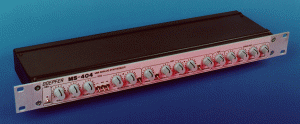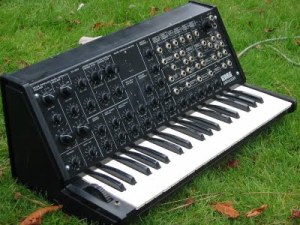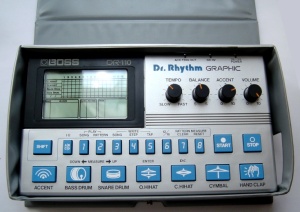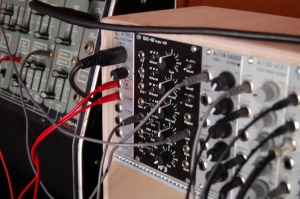Anthony Rother speaks about his music, workflow and set up in his studio.

Tag Archive for techno
synthetizers
Doepfer MS-404 review
by synthvibrations • • 0 Comments
The Doepfer MS404 was designed as a TB emulator with a lot of added features in a period full of cheap and expensive tb clones.
The 404 in fact is not a clone but has a clear personality and can be considered more a single VCO monosynth.
First I want to describe the structure of the synth: a single VCO , with saw/pulse/PWM or noise with a 24dB ladder filter, a VCA with accent and a adsr Envelope generator and two indipendent LFO that can go up to audio frequency!
The VCO seems to be the A110 “standard vco” available as a module for the A100 modular system, but opening the case , I read on the board “HI END VCO”,and that sounds strange because I did not see any CEM3340 as on the A111 “hi end VCO”.
The VCO section has 5 knobs and 3 swithches.
Knobs are: GLIDE, TUNE (fine tune) , LEVEL (LFO1 amount) FREQ (LFO1 rate).
the switches select:
- saw/pulse/none
- vco/noise/none
- pwm/fm/none
- rate (hi-mid-low)
The VCF section has 5 knobs :
- Frequency
- Envelope
- Modulation level(LFO2)
- Modulation Frequency (LFO2)
- Emphasis (Resonance)
and 2 switches : one for the filter tracking and omne for the LFO2 range (hi-mid-low).
The VCF is the same as the A120 MOOG ladder filter eurorack module for the A100.
The VCA has a knob control for the accent amount and the envelope is the classic adsr.
speaking about the sound the 404 has a distinct doepfer carachter, it sounds exactly as the A100 modular system, no audible differences.
The synth behaves as a tb clone if the added features are not used, and with the emphasis quite low.
When you rise the emphasis it takes squelching in a more hard way and at self oscillation it can produce a sine wave , musically playable switching the filter tracking ON.
the PWM sounds awesome, I like it very much, because it does not intend to clone but has a “new minimal sound” very interesting for those involved in minimal techno like Ritchie Hawtin…
It does not sound nor similar to a Roland SH-101, this is more acid and hard, the SH is fuller on low frequencies and smoother.
The interesting feature that makes the doepfer ms 404 a distinct machine is the use of fast lfo to modulate VCO and VCF.
The LFOs are derived from the A145 (doepfer A100 system) and have a range switch that allows very low oscillation to fast audio range FM.
That’s interesting because the filter is a 24dB Moog Ladder type, a filter that has a fast reaction to modulations and can create incredibles sounds if modulated in self oscillation or nearby…
Using the other LFO on the VCO can create some interesting noise or FM sounds useful for percussions, drones etc.
One thing to say…
The waveform orf the LFOs are fixed, triangle or square and you can choose the one you want to use only using a jumper on the board, there are no external switches.
The impression I had playng the MS 404 is really good.
This is a interesting bassline synth , not so good at emulating the classic TB sound, but this is a good point!
Other than that can be used as a classic monosynth with a great modulation capability, and many sounds with a small amount of functions and knobs.
There is also an audio in (with gain) to process external audio signals and a cv-gate interface (in/out) so the 404 can be played trhu cv by an analog system/sequencer or can be used to control other cv-gate synth.
I prefer the 404 to a Basstation , for example , it sounds more interesting and “analog” and is not the “wannabe everything” emulator.
modulars, retrò & vintage, synthetizers
Korg MS-20 review (Part-1)
by synthvibrations • • 0 Comments
The Korg MS-20 is one of the most famous vintage synths ever.
It stands up there with the Minimoog, ARP 2600, EMS Synthi, Jupiters, TB-303, etc.
When it was produced , Korg marketed it as a low cost “baby 2600″ , it was the semimodular synth for the masses.
The look is somehow inspired by the big Moog modulars, with the front panel that stads upright the keyboard, that is attached to the body, to be the most compact and portable, all in a typical japanese way.
The synth is divided into two parts : the left side , prepatched with the knobs and the right side , the patchable with the patchbay and external signal processor.
The synth has:
- 2 VCO (with different waves)
- VCO MIXER
- 2 VCF (HPF and LPF 12 dB/oct, both resonant)
- VCA
- MODULATION GENERATOR (LFO)
- 2 ENVELOPES
VCOs
The 2 VCOs have different settings capabilities and different functions.
VCO1 has:
WAVE SELECTOR:
- TRIANGLE
- SAW
- PULSE WAVE (with manual pw)
- NOISE
PW KNOB
SCALE (32-16-8-4)
VCO2 has :
WAVE SELECTOR:
- SAW
- SQUARE
- PULSE
- RINGMOD
PITCH KNOB (fine tuning)
SCALE (16-8-4-2)
The two vcos sounds very warm and fat with a classic japanese sound.
The saw waves are quite “smoothed” and not really ripping (as the classic american saw of moog , sequentials, etc.)
The pulse/square wave is really fat and smooth too.
The smoothness of the oscillators maybe also produced by a particular “cut” of the VCFs and VCA that are not bypassable.
VCFs
The filters are the most carachteristic element of this synth, the trademark of the MS20′ sound is the dual filter with resonance (PEAK).
Both the HPF that the LPF have the same controls, the FREQUENCY CUTOFF and the PEAK (that’s the RESONANCE!).
The slope of the filters is 12dB/oct and though they are resonant they are not self oscillating.
The use of the filters makes this synth anhighly versatile machine, because they are not strightly “multimode”, but can be used in combo to obtain particular combinations mantaining two indipendent peaks of resonance.
A famous use of the HPF is to boost the low frequencies oto saturate the sound.
Thanks to the resonant HPF , turning up the peak creates a gain of level at the cutoff frequencies that results in awesome sub basses or highly saturated sounds.
The behaviour of the filter is also particular because when the peaks are up the frequency of the cutoff tends to oscillate producing highly harmonic and saturated timbres.
The MS20 was produced with two different components , the first (older) series has the famous Korg35 that is considered less “muddy” , while the following series use common components.
Both the HPF that the LPF have a smooth behaviour and a rounded sound with the peaks at minimum, while raising up the peaks leads to the aggressive and distorted side of the synth.
ENVELOPES
Env 1 is a simple Attack -Release with Delay,useful for modulations and harpached to the VCO pitch modulation.
ENV2 is a HADSR, it works like an ADSR but has a hold for that lovely drones the MS20 is so great at, or to use the synth as a efx/filter processor for external signals.
ENV2 is prepatched to VCA and VCFs modulations.
Both the envs are punchy with fast attack and decay, and work very well for every type of sound, from percussive to ethereal.
MODULATION GENERATOR
MG is how Korg labelled the LFO.
The MG consist of a low frequency oscillator that produces morphable square and saw waves .
The saw can morph from saw to tri to ramp.
The square goes from imp to square to inverted imp.
The two row of knobs under the filter and vcos sections are dedicated to the modulations.
The higher row has the MG as modulation source,and the pitch, and cutoff of the filters as destinations, while the lower row has as source the ENVs, env 1 to pitch and env2 to filters.
Every parameter has its own amount knob.
On the left there are two keyboard controls, PORTAMENTO and tune.
This is a description of the “prepatched” part of the synth, but using the patchbay almost everything can be routed to every target, the flexibility is one of the most important carachteristic of the MS 20, a compact synth , highly versatile and awesome sounding.
drum machines, retrò & vintage
Roland TR 606 videos
by synthvibrations • • 0 Comments
Uncategorized
Roland TR-606 review
by synthvibrations • • 0 Comments
The Roland TR-606 was the cute sister of the great TB-303.
Roland intended to sell this pair of silver boxes to guitar players or organ players as substitutes to a bassist and a drummer.
But in the early 80s , when the popularity of sample based drum machines was growing up with the Linn drum, Oberheim DMX, Emu Drumulator, the TR-TB combo sounded really poor and unnatural to rock players who were astonished by the fidelity of the sampled sounds.
So the poor silver boxes were sold just for practicing musicians on a budget.
During the 80s many electronic bands with low budget started using both the 606 and the 303 till , in 87/88 DJ Phuture enstablished the sound of the TB-303 as a new mainstay in the dance culture.
The TR606 , often used in early new wave electro-bands became famous as a great techno drum machine, along with its bigger sisters the TR 808, TR909.
So, despite its limitation the TR606 has gained its place in electronic music appearing in many awesome records by Aphex Twin, Squarepusher, Autechre, Kid 606, 808 STATE and many more…
The TR606 is a fully analog drumsynth with a digital sequencer.
The machine has seven sounds plus accent.
- Accent
- Bass drum
- Snare drum
- Lo tom
- Hi tom
- Cymbal
- Open hat
- Closed hat
The sequencer is really pretty easy to use.
It can be programmed in Step or Realtime, and is the classic 16 step TR sequencer.
You select the instrument and press the step that corrispond to the trig you want.
Really easy and user friendly!
The sequencer can also be used trig synth arpeggiators or other old machines with sync in.
The two toms have two triggers out to do it.
The 606 has a din port to sync (in or out ) with other machines that use the Roland sync 24.
The sounds are typical electronic analog sounds very close to the TR808, but with their own carachter.
The TR606 has a more aggressive and less smooth tone compared to the 808, it could be the 808 on acid!
The bassdrum kicks in a medium range, the snare is hard and snappy the hats and cymbal are really tinny, while the toms are great for that tribal electro rhythm.
This is a great analog drum machinee that’ is growing in price and popularity, I love mine and I think any electro/techno producer should own one!
drum machines, retrò & vintage
BOSS DR-110 review
by synthvibrations • • 0 Comments
This little cute box is a fully analog drumachine with a graphic sequencer.
The unit is really tiny and portable and offers six sounds plus accent.
The sounds are:
- Accent
- Bass drum
- Snare drum
- Open hihat
- Closed hihat
- Cymbal
- Hand clap
There are four knobs :
- Tempo (fast-slow)
- Balance
- Accent
- Volume
The tempo is controlled by the knob but the machine does not display the value of the BPM.
The balance act as a mix between the drum & snare and hats & cymbal.
Accent controls the “accented”sound , in fact it does not only affect the volume of the percussion accented but also the timbre.
Volume is the Master Volume.
The sounds are the classic analog drum sounds of Roland CR/TR series.
The kick is really similar to the one of the TR808 and of the CR8000 , fat and punchy, much deeper and full compared to the TR-606.
The snare is really snappy and can be a cross between a TR808 and a TR606.
Hats and cymbal resembles the TR606, while the clap is a classic tr808 one.
Programming is similar to the CR series with the pause/trig style , but is far easier than on CR78 or CR8000 because here we have a disply with the programming grid!
The display is really similar to the one on the TR707 or TR727 , all the elements are displayed and is like programming on cubase or any other software sequencer.
The START acts as TRIG and the STOP as PAUSE.
The Accent acts also as TRIG OUT INST.
The downside of this machine is the absence of a clock in , but many modifications are available to install a sync in or even midify the machine.
All in all an awesome little beast that comes really cheap!
music, synthetizers
Acidlab Bassline video
by synthvibrations • • 1 Comment
modulars, synthetizers
Analogue Solutions SY02 – Multimode Filter review
by synthvibrations • • 0 Comments
I’m a great fan of the Korg MS-20, as it’s one of my favourite synths ever, so I decided to expand my modular with an MS-20 filter clone.
There are many emulators/clones in eurorack format for the Korg filter, but I focused on three modules:
- Doepfer X-treme filter
- Malekko (Wiard) Borg (Buchla-Korg)
- Analogue Solutions SY02
I like the Borg but it works only as a multimode filter that can out put only one signal, so it’s quite limited.
The Doepfer is interesting but I found the ASOL the more versatile and at the same time interesting as carachter.
The first thing to say that THIS IS NOT THE MS-20 FILTER!
In its way it can have common caracteristics and sounds very similar but it’s not the same.
The module has a vertical row of connections for CVand audio INs on the left and the knobs on the right.
There is a an INPUT LEVEL to adjust the gain for the incoming sounds, that useful to saturate or lead the filters to overdrive.
On the left there are 2 AUDIO IN .
Than there is the HIGHPASS Filter section with
- Cutoff
- Resonance
- HPF CV
The HPF CV has 2 CV in the first is attenuated by the knob while the second has no attenuation control.
The LOWPASS Filter section has the same controls:
- Cutoff
- Resonance
- LPF CV
As for the HPF even the LPF filter has 2 cv in and only the first is attenuated by the LPF CV.
There is aslso a VCA section with :
- Initial Level
- Volume
- Audio out (minijack)
The VCA has its 2 CV IN not attenuated.
This module is the FILTER/VCA section usedon the Analogue Solutions VOSTOK too, the construction is solid and the VCA it’s a really good add o this filter.
The filters have a really particular response , tryng to emulate the Korg MS-20 filters/VCA, and the input gain is the key to get smooth sounds or enter in noise territory.
I’ve patched the synth in a very simple way to understand clearly the behaviour of this module.
I’ve patched only the first vco (from my MFB OSC02) directly into the first audio in of the sy02, used the MFB Dual ADSR to control the vca ancd the LPF.
With a low input level the sound is really mellow and “japanese”, smooth and deep.
As I turn the input level clockwise, the waveform gain in volume and in saturation until “distortion”.
Distorion is like a good overdriven sound , not a clear distortion.
As the filter , with a low input level flows into the filters they react quite smoothly and the resonance has a pleasant harmonic sound but reaches only little aggressive tones.
As the input level grows the filters start to saturate and overdrive the sound, and using ring mod with saw sources it creates a particular clipping , like if it would cut and drive the peaks of the saw waves.
A really interesting trick that every MS-20 user knows is using the HPF as a frequency booster.
In fact the resonance of the HPF can produce a really big amount of sub frequencies usable to fatten up the sound.
If the HPF is controlled with the tracking of the keyboard it can create very powerful SUB basses.
Behond the FILTERS there’s a good (in my opinion) VCA that concurs to give a strong carachter to the module.
The VCA does not ave a superfast response or a extra dynamic behaviour, but it’s very warm and full, really musical!
For me it’s very important for a module to be “musical” because too often a modular synth can do amazing noises but cannot play a bass sound , and that’s quite absurd.
Doepfer modules (like the A-132-3 DVCA I own) have a cleaner sound and more volume but are less musical (in my opinion but maybe you will like it), and I find this useful for percussive sounds or effects and less pleasant for melodic sounds.
Back to the SY02 , I’m really happy with this module, it has a certain retrò/MS-20 touch, but it also has a carachter of its own.
I really recommend it to everyone looking for a japanese touch in his modular sounds!
modulars, synthetizers
Eurorack vs Roland System-100 audio demos (part2)
by synthvibrations • • 1 Comment
Yesterday I tested the MFB VCO and the MFB Dual ADSR with my Roland System100 mod 102, during the test I did some demo recordings.
The demos are quite long and in every demo I used the same “sequence” and tweaked the knobs to let you hear the behaviour of the system.
As the melody is quite redundant I hope you don’t get annoyed and focalize your attenction on the sounds.
- VCO MFB with Roland filter
The MFB VCO (only one vco) passes trhu the Roland System100 filter.
First I use a saw wave then a square without any modulation and play with the filter to show as the the two modules interact.
- VCO MFB with System100 and MFB Dual ADSR
The MFB VCO pass thru the Roland filter and the MFB env modulates the Roland filter cutoff.
It starsts with a saw wave , than at 1’30 I switch to the PWM and continue playing with the filter and with the MFB env.
At 4’50 I turn the Roland VCO volume up…
- VCO PWM (Roland System100 vs MFB)
Here’s a comparison between the two vco passing thru the Roland System100.
They both produce the PWM with a similar rate, the MFB sounds a bit harder, it may need an attenuator for PW mod…
The first is the Roland and the second is the MFB
- VCO SAW (MFB vs Roland System100)
Here’s the comparison between the two saw, the first is the MFB the second is the Roland
PAY ATTENCTION!!
When you listen to the sound keep the volume at a fixed level, don’t turn up the volume when some sounds seem more quiet because there are some resonance peaks that can DAMAGE your speakers and your EARS!
retrò & vintage, synthetizers
Eurorack modular vs Roland System100 Mod-102 (Part 1)
by synthvibrations • • 0 Comments
As I described some days ago , I’m building a little modular in eurorack format to have a little versatile synth to make modular sounds easy, and to expand my system of vintage semimodular synths:
- Roland System100 MOD-102
- Korg MS-20
- Korg MS-50
- Korg PS-3100
The Korgs work well altogether as they use the same korg “standars” as 1/4″ plugs, hz/volt , etc.
The system is well balanced and is very versatile , there are no tuning problems and connections between one module and the other has no need of attenuators and result open to every use.
The Roland System 100 is quite different, it uses 3,5mm plugs, 1volt/oct and is quite difficult to make it interact with the Korgs even because the sound of the Roland is “stronger”.
After analizing different solutions (the first was to buy the other parts : mod 101 the keyboard, the sequencer and the mixer, while the second was to buy a System100m…) I decided to buy an eurorack to have a synth easier to control with computers and midi devices , more stability and however the freedom to build a synth choosing every part.
The result is, as I described, a synth with basic elements that are quite different from the “new analog” I own (DSI Evolver desktop and Studio Electronics ATC1 and SE1), but quite versaatile for a wide range of sound including FM modulations.
The first thing I tried is the interfacing between the Eurorack and the Roland and I was surprised they interact very well .
The Midi-CV interface works very well with the System100 too (I use a Kenton Pro 2000 for it, usually..).
The first thing I tried was to compare the Roland VCO with the MFB VCOs and I was quite surprised.
The Roland is really thick on the lower frequencies, and the square waves are awesome , but the MFB is really good too and they have a similar sound in many ways.
The MFB is less deep , especially when you hear in A->B comparison , and a little darker on the highest frequencies, but does a really a well job fattening the System100 sound without sounding different.
What makes the BIG difference is the Roland Filter.
Using only the MFB VCO in the roland path , with the roland VCO with zero volume, the result is amazing.
The VCO sound smooth and rich, really fat on the lower range and really harmonic and “creamy” in the higher register.
The big difference is evident in the lead sounds, they sound smooth with big carachter and warm sound without being harsh or disturbing but always rich of mid and high harmonics.
As the resonance grows the sound became quite acid (the typical roland filter carachter) but with growing harmonics, and a massive warm sound.
Then I tried to use the MFB dual ADSR to compare the behaviour of the two type of env and even here the different is evident.The Roland one is FAST and SNAPPY but always “rounded”, more musical, and gives the synth the classic Roland touch.
The MFB ENV is really fast, maybe faster than the Roland, but also more angular, with the attacks at zero makes a “ping” sound at the trig of the note.
Maybe the voltage that this env produce is higher and should be attenuated to get more musical results, even if the different behaviour is really interesting to get different result.
The first thing done was a sequenced upright bass that sounded really awesome.
I did the same sound using only the eurorack and the sound was similar but more enarmonic, the reason is without any doubt the different between the two filters.











